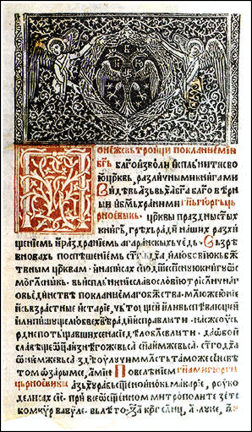Serbian Medieval History
Ivan Crnojevic (1465 - 1490)
Upon the definitive Ottoman conquest of the central Serbian realm, the southwesterly province of Zeta was initially spared - it continued a semi-independent existence for another four decades, facing and often relying on the Venetian presence in the southern Adriatic. This was accomplished under the leadership of princes from the house of Crnojevic, the most prominent member of which was Ivan (sometimes referred to as Ivan-beg).
While Ivan's foreign dealings and his realm were generally of minor importance, as its conquest was a mere sideshow in the Ottoman subjugation of Europe, the rule and internal deeds of this ruler and his sons have considerably larger historical significance. In many ways, this period represents a key bridge - perhaps even a "missing link" of sorts - between the distant (and sometimes legendary) times of medieval Serbian statehood, and the later period of Turkish yoke and national liberation struggle culminating in the 19th c. This is signified by the changes that occurred during this rule - and symbolized by the switch of reference from the medieval Zeta to modern Montenegro ("Crna Gora" in Serbian). It is exemplified by the shift of Ivan's capital from the lowland Zabljak first to the hilly Obod and finally to the mountainous Cetinje, and evident in many other ways: the trade-oriented monetary economy and farming of the coastal and lowland cities and adjoined areas is replaced by a more primitive economy based on stock-raising and even brigandage; as the quality farming lowlands are abandoned in favor of very sparsely populated barren mountains, landed aristocracy and feudal landholdings disappear and get replaced by a clan-oriented, patriarchal society organization; the significant and increasingly aggressive coastal-based Venetian Catholic influences whither away as the Metropolitan of Zeta also shifts his seat to Cetinje, thus establishing a staunch Orthodox presence. The Crnojevics - in contrast, say, to previous feudal lords from Zeta - figure prominently in the epics, where they appear in some of the finest poems (like the famous "Wedding of Maksim Crnojevic") as the last, if modest, medieval dynasts in the Nemanjic tradition - with a court in a castle, court officials, monastery endowments and the like. On the other hand, the later line of Cetinje prince-bishops that continuously led the increasingly autonomous Montenegro in the centuries that followed, directly traced its roots to Ivan Crnojevic and the marvelous monastery he had dedicated to the Holy Virgin. Legend has it that key Serbian nobility fled to the area under Turkish pressure, and founded the prominent later tribes and clans. In many ways, that Montenegro, isolated and self-sufficient, managed to harbor the purest Serbian epic tradition and the Kosovo-Nemanjic collective memory. The foundation laid down by Ivan Crnojevic and his sons was instrumental in facilitating much of that.
 The last independent South Slavic medieval dynast Ivan Crnojevic's son Djuradj is described by sources as tall, brave, a fine horseman, and lover of books. It is in this last category that his short reign left a lasting legacy. Based on early Venetian models, he had an indigenous printing press created in Montenegro. Its products were of the highest quality, as is evident here from a page of the famous Oktoih.
The last independent South Slavic medieval dynast Ivan Crnojevic's son Djuradj is described by sources as tall, brave, a fine horseman, and lover of books. It is in this last category that his short reign left a lasting legacy. Based on early Venetian models, he had an indigenous printing press created in Montenegro. Its products were of the highest quality, as is evident here from a page of the famous Oktoih.
Others
More Information
BLAGO Content
While the content of the BLAGO Fund collections is free to use, there are also some restrictions on commercial use and proper attribution of the material. Follow the links below for more information.
> BLAGO Collections License
> Image Request
BLAGO Fund also accepts the contribution of material. Please contact us with any material you wish to publish on our website.
Contact
BLAGO Fund, Inc.
PO Box 60524
Palo Alto, CA 94306
USA
info@blagofund.org

